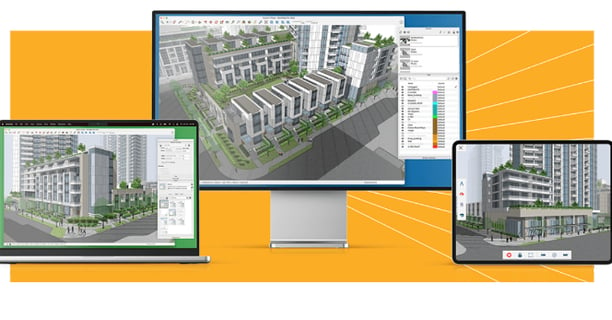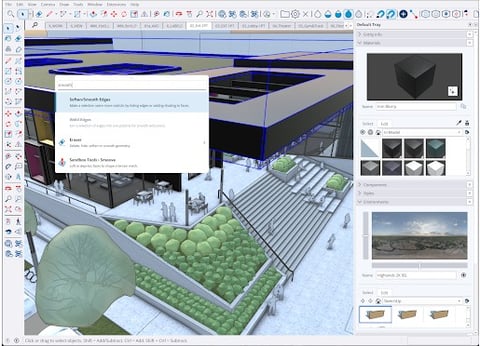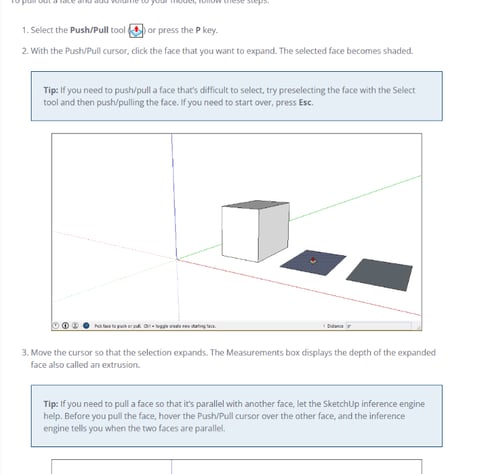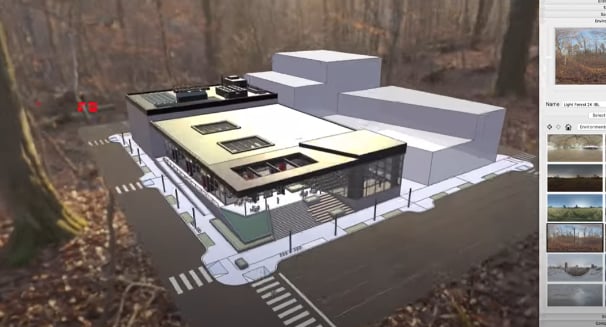
SketchUp Review: The Easy-to-Use 3D Design Software for Everyone 2025
Discover why architects, designers, hobbyists, and students choose SketchUp to bring their 3D ideas to life quickly and easily
SketchUp: Key Takeaways
Core Technology
Intuitive push/pull interface with simple 3D modeling tools. Features a library of over 4 million pre-built objects and materials in the 3D Warehouse. Available as web-based, desktop, and iPad applications.
Evaluating SketchUp for your 3D design projects? Here's what technical professionals and hobbyists need to know about this popular modeling software.
Pricing Structure
Multiple tiers from Free (web-only, limited features) to Studio ($749/year). Professional version at $349/year. Educational licenses available for $55/year. Subscription-based model with no perpetual license options. (Correct as of April 2025)
Best Applications
Ideal for architects, interior designers, landscape architects, and hobbyists needing quick 3D visualization tools. Excellent for conceptual design, client presentations, and early-stage modeling. Perfect learning platform for students and beginners in 3D design.
Technical Features
Built-in terrain modeling, shadow studies, cross-section tools, and integration with rendering extensions. Pro and Studio versions include LayOut for 2D documentation, PreDesign for climate analysis, and extension support.
System Requirements
Desktop version needs moderate hardware (8GB+ RAM recommended). Web version runs in modern browsers with lower resource demands. Newer versions benefit significantly from dedicated graphics cards. Mobile version optimized for iPad.
Technical Limitations
Limited parametric modeling capabilities compared to advanced BIM software. Performance can slow with very complex models. Some professional features require paid extensions. Not suitable for highly detailed engineering work or complex simulations.
Note: We may earn a small commission if you buy through our links. This helps us keep testing and comparing software - and doesn't affect our honest opinions!
What is SketchUp?
Have you ever wanted to create your own 3D designs but felt overwhelmed by complicated software? SketchUp might be just what you need. This popular 3D design tool helps turn simple ideas into 3D models. Whether you're planning a home renovation, designing furniture, or working on a school project, SketchUp can help to make the process much easier.
In this review, we'll look at everything SketchUp has to offer in 2025. We'll cover the different versions, their costs, capabilities, and who they're best suited for. By the end, you'll know if SketchUp is the right tool for your needs.


SketchUp Versions: Which One is Right for You?


SketchUp Go
Cost: $119/year or $17.99/month
Where it works: Web and iPad
Best for: Hobbyists and on-the-go designers
Key features: Cloud storage, 3D Warehouse access, AR viewers
SketchUp Free
Cost: $0 (Free)
Where it works: Web browser only
Best for: Beginners, students, casual users
Limitations: Basic features only, limited storage
SketchUp comes in several different versions. Let's break them down to help you choose the right one:
SketchUp Pro
Cost: $119/year or $17.99/month
Where it works: Web and iPad
Best for: Hobbyists and on-the-go designers
Key features: Cloud storage, 3D Warehouse access, AR viewers
SketchUp Studio
Cost: $749/year
Where it works: Web, iPad, and Desktop
Best for: Advanced professionals needing all features
Key features: Everything in Pro plus Revit import, V-Ray for realistic rendering, point cloud modeling
SketchUp for Schools
Cost: Free for schools with Google Workspace or Microsoft Education
Where it works: Web (Chromebooks or any internet-connected computer)
Best for: Teachers and students in K-12 education
Key features: Lesson plans, Google Drive/OneDrive storage
Educational Licenses
Cost: $55/year for students and educators
Where it works: Web, iPad, and Desktop
Best for: College students and professors
Key features: Similar to Studio but at a deeply discounted price
*Prices are correct as of the time of writing the article in April 2025.
Who Uses SketchUp?
SketchUp isn't just for professional architects and designers. Many different people use it:
Students learning about design and 3D modeling
Homeowners planning renovations
Teachers creating educational projects
Interior designers visualizing room layouts
Landscape architects designing outdoor spaces
Construction workers planning building projects
Hobbyists making fun 3D creations
The software is used across many industries, especially in architecture approx 19%, higher education approx 10%, design approx 9%, and construction approx 6%. Over 1,150 companies use SketchUp, with many of them being small to medium-sized businesses.
What Computer Do You Need for SketchUp?
To run SketchUp smoothly, you'll need different hardware, depending on which version you use.
For Web Versions (Free and Go):
Minimum: 2.1+ GHz processor, 4GB RAM, 700MB free space
Recommended: 2.8+ GHz processor, 8GB+ RAM, 1GB+ free space
Browser: Chrome, Firefox, or Edge (latest versions)
For Desktop Version (Pro and Studio):
Windows Minimum: 1 GHz processor, 4GB RAM, 1.5GB free space
Windows Recommended: 2+ GHz processor, 8GB RAM, 2GB free space, dedicated graphics card
Mac Minimum: 2.1+ GHz Intel processor, 4GB RAM, 1.5GB free space
Mac Recommended: 2.1+ GHz processor or Apple M1 chip, 8GB RAM, 2GB free space, dedicated graphics card
Operating System: Windows 10/11 or macOS 12 (Monterey) or later
For iPad:
Works on most modern iPads
Best with Apple Pencil and an external keyboard/mouse
The new SketchUp 2024 has an improved graphics engine that makes better use of your computer's graphics card, but it needs more powerful hardware to run properly.


Key Features: What Can You Do with SketchUp?
Easy 3D Modeling
SketchUp is known for its "push/pull" tool that makes 3D modeling simple. You can draw a 2D shape and then pull it up into 3D with just one click. This makes it much easier to learn than other 3D software.
3D Warehouse
One of SketchUp's best features is the 3D Warehouse. It is an online library with over 4 million pre-made 3D models that you can download for free. Instead of making everything from scratch, you can find models of furniture, cars, buildings, plants, and more.
Terrain and Landscape Tools
If you're designing outdoor spaces, SketchUp has tools for creating realistic terrain. You can:
Import contour lines to make 3D landscapes
Sculpt the ground with the "Smoove" tool
Add elements like roads, water features, and plants
Sunlight and Shadow Studies
SketchUp can show how sunlight hits your design at different times of day and in different seasons. This is super helpful for:
Planning window placement in a house
Finding the best spot for a garden
Checking if a building will cast shadows on neighbors
LayOut (Pro and Studio only)
LayOut lets you turn your 3D models into professional 2D drawings and documentation. You can add dimensions, text, and other details to create presentations or construction documents.
How Easy is SketchUp to Learn?
One of SketchUp's biggest strengths is how easy it is to learn. Most people can start making simple 3D models within a few hours. The basic tools are intuitive - you can draw lines, push and pull surfaces, and move around your model without much training.
That said, becoming really good at SketchUp still takes practice. Here's a rough timeline:
1-2 hours: Learn basic navigation and simple shapes
1 week: Create basic buildings and objects
1 month: Design detailed models with proper techniques
3+ months: Master advanced features and workflow efficiency
There are tons of free tutorials online that can help you learn SketchUp quickly. The software also has a helpful community where you can ask questions when you get stuck.
SketchUp on Different Devices
Desktop Experience
The desktop version (available with Pro and Studio subscriptions) gives you the most powerful tools and best performance. This is the best choice for serious work and complex models.
Web Experience
The web version works in your browser without installing anything. It's convenient but has fewer features and might run slower with big models.
iPad Experience
SketchUp for iPad (included with Go subscription) lets you create and edit 3D models on your tablet. It's optimized for the Apple Pencil and touch controls. This is great for designing while traveling or presenting ideas to clients.
How Does SketchUp Compare to Alternatives?
Let's see how SketchUp stacks up against other popular 3D design software:
SketchUp vs. AutoCAD
Ease of learning: SketchUp is much easier to learn
Technical precision: AutoCAD is more precise for technical drawings
Price: AutoCAD is significantly more expensive
Best for: SketchUp for quick 3D concepts, AutoCAD for detailed 2D engineering drawings
SketchUp vs. Revit
Building Information Modeling (BIM): Revit has better BIM capabilities
Learning curve: SketchUp is simpler to learn
Collaboration: Revit has better tools for large team projects
Best for: SketchUp for conceptual design, Revit for comprehensive building design
SketchUp vs. Blender
Price: Blender is completely free
Versatility: Blender does more (animation, rendering, etc.)
Ease of use: SketchUp is easier for beginners
Best for: SketchUp for architectural design, Blender for creative 3D art and animation
Pros and Cons of SketchUp
What We Love
Easy to learn: The simple interface makes it accessible for beginners
3D Warehouse: Millions of free models save tons of time
Versatile: Works for many different types of projects
Multiple versions: Options for every budget and need
Great visualization: Makes it easy to show ideas to clients
What Could Be Better
Subscription model: Moving away from one-time purchases means ongoing costs
Performance with large models: Can slow down with very complex designs
Limited advanced features: Not as powerful as some specialized software
Extra extensions needed: Some useful features require paid plugins
Pricing increases: Some long-time users feel prices have risen without enough new features


Is SketchUp Worth the Money in 2025?
Whether SketchUp is worth the cost depends on your specific needs:
For hobbyists and occasional users: The free version is great for simple projects, while the Go subscription ($119/year) offers good value if you want more features and iPad support.
For professionals: The Pro version ($349/year) is worth it if you regularly create designs and need professional documentation tools. The cost is reasonable compared to many alternatives.
For advanced users: The Studio version ($749/year) is expensive but includes powerful features like V-Ray rendering. It's worth it if you need these advanced tools regularly.
For students and educators: The educational pricing ($55/year) is an excellent deal, giving you almost all features at a fraction of the regular price.
Remember that SketchUp saves you time, which is valuable, especially for professionals. The easy learning curve means you'll be productive much faster than with more complex software.
*Prices are correct as of the time of writing the article in April 2025.
Our Verdict
SketchUp remains one of the most user-friendly 3D design tools available in 2025. Its unique balance of simplicity and power makes it accessible to beginners while still being useful for professionals.
The continued improvements to the software, especially the new graphics engine in the 2024 version, show that development is ongoing. While the subscription model may not please everyone, it's become standard in the software industry.
We give SketchUp an overall score of 8/10. It excels in ease of use and visualization capabilities but could improve in advanced features and performance with very complex models.
Whether you're a student, hobbyist, or professional, there's likely a version of SketchUp that fits your needs and budget. We especially recommend it for:
People new to 3D modeling
Architects and designers who need quick concept development
Landscape designers
Interior designers
Educational settings


Frequently asked questions
Is SketchUp good for beginners?
Yes! SketchUp is one of the easiest 3D modeling programs to learn. The free version is a great place to start.
Can I use SketchUp for free?
Yes, SketchUp Free is available through any web browser at no cost. It has limited features but is perfect for learning and simple projects.
Does SketchUp work on Mac and Windows?
Yes, the desktop version works on both Mac and Windows computers. There's also a web version that works on any computer with a modern browser.
Can I use SketchUp on my iPad?
Yes, there's a version specifically for iPad that's included with the Go subscription. It works best with an Apple Pencil.
What's the difference between SketchUp Free and SketchUp Pro?
SketchUp Free is web-only with basic features, while Pro adds the desktop application, LayOut for documentation, more import/export options, and access to extensions.
Can SketchUp create professional architectural drawings?
Yes, with the LayOut tool (included in Pro and Studio), you can create detailed 2D drawings with dimensions and annotations suitable for construction.
How much computer power do I need to run SketchUp?
For basic models, most modern computers will work fine. For complex projects, we recommend at least 8GB of RAM (16GB is better) and a dedicated graphics card.
Stay Updated
We test these tools regularly and update this post regularly. Last checked: February 2025.
If you would like to join our newsletter for more tip, tricks and review just enter your email below.
